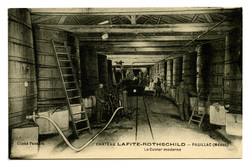Château Lafite, Pauillac, France
The Rothschild purchase
Baron James de Rothschild (1792-1868), founder of the Paris Rothschild bank, was a connoisseur of good wine and equally attracted by the prospect of acquiring a top Médoc estate as an investment. As early as 1830, James made an offer on the estate but the proprietors were unwilling to sell. In fact, James had to wait until July 1868 before Lafite came up for auction again. A reserve price was set at four and a half million francs, with a further quarter of a million for the neighbouring Carruades estate. It was not reached. Lafite was withdrawn from sale. It was put up for sale again in Paris on 8 August, with the reserve reduced to 3 million and a quarter of a million for the Carruades. Agents acting on behalf of James de Rothschild, were successful, paying 4,140,000 francs for Lafite and 300,000 for the Carruades (as much as the earlier sale prices of Mouton, Margaux and Chateau Palmer put together).
A letter from James on 11 August 1868 opens with the words: “Dearest nephews, thank you so much for your good wishes on buying the vineyard. I hope with God’s help we will be able to drink the wine together in good health.” His hopes were misplaced. James died on 15 November, never having set foot on the property. Upon his death, Lafite was divided between his three surviving sons, Mayer Alphonse (1827-1905), Gustave (1829-1911) and Edmond (1845-1934).Edmond learned a good deal about wine from the experts at Lafite and subsequently went on to create vineyards in the colonies he founded in Palestine. But, on the whole, banking left the three brothers little time to devote to the vineyard.
The Second World War
During the Second World War, Lafite was requisitioned by the occupying German forces. Production continued and the stocks of wine were left untouched; it was believed that Goebbels had earmarked them for the celebration of eventual German victory. Meanwhile, the Germans installed electricity for the first time and installed modern plumbing. After the War, Baron Elie de Rothschild (1917-2007) led a programme to restore the vineyard.
Revival
It was not in fact, until Elie took over as chairman of Lafite in 1946, that it began to make a profit. He cared passionately about Lafite, which served to intensify the friendly rivalry between Château Lafite and Château Mouton Rothschild. (Mouton had been purchased by Nathaniel de Rothschild (1812-1870), the son of Nathan Mayer Rothschild (1777-1836) in 1853. In the 1920s Philippe de Rothschild (1902-1988) brought a new vigour to it with an imaginative style of innovation, introducing the tradition of wine labels painted by great artists. In 1973, it joined Lafite as a premier cru, two of the world’s finest wines side by side on the slopes of Pauillac).
The shock of nationalisation of the French Rothschild banking business in France in 1981 determined Eric de Rothschild (b.1940), who had taken over from Elie at Lafite, to take a keener look at Lafite and its commercial possibilities. The result was a reorganised winemaking group, operating as Domaines Barons de Rothschilds, under the control of Lafite. In South America, Les Domaines Barons de Rothschild took the bold step in 1988 of acquiring a 2000 hectares estate, Vina los Vascos, in the Mount Caneten Valley close to the Chilean coast. This venture was followed up in 2001 by the announcement of a joint venture with Nicolas Catena, creator of a flagship winery in Mendoza, to produce a Cabernet Sauvignon/Malbec blend near Godoy Cruz in Mendoza from grapes sourced from several Catena vineyards. In April 2018, Baron Eric's daughter, Saskia de Rothschild became the youngest person to lead a first growth Bordeaux estate, also becoming the first female chairwoman of Domaines Barons de Rothschild (Lafite), the extended family's global wine business.
Château Lafite Rothschild website
Return to Estates listing